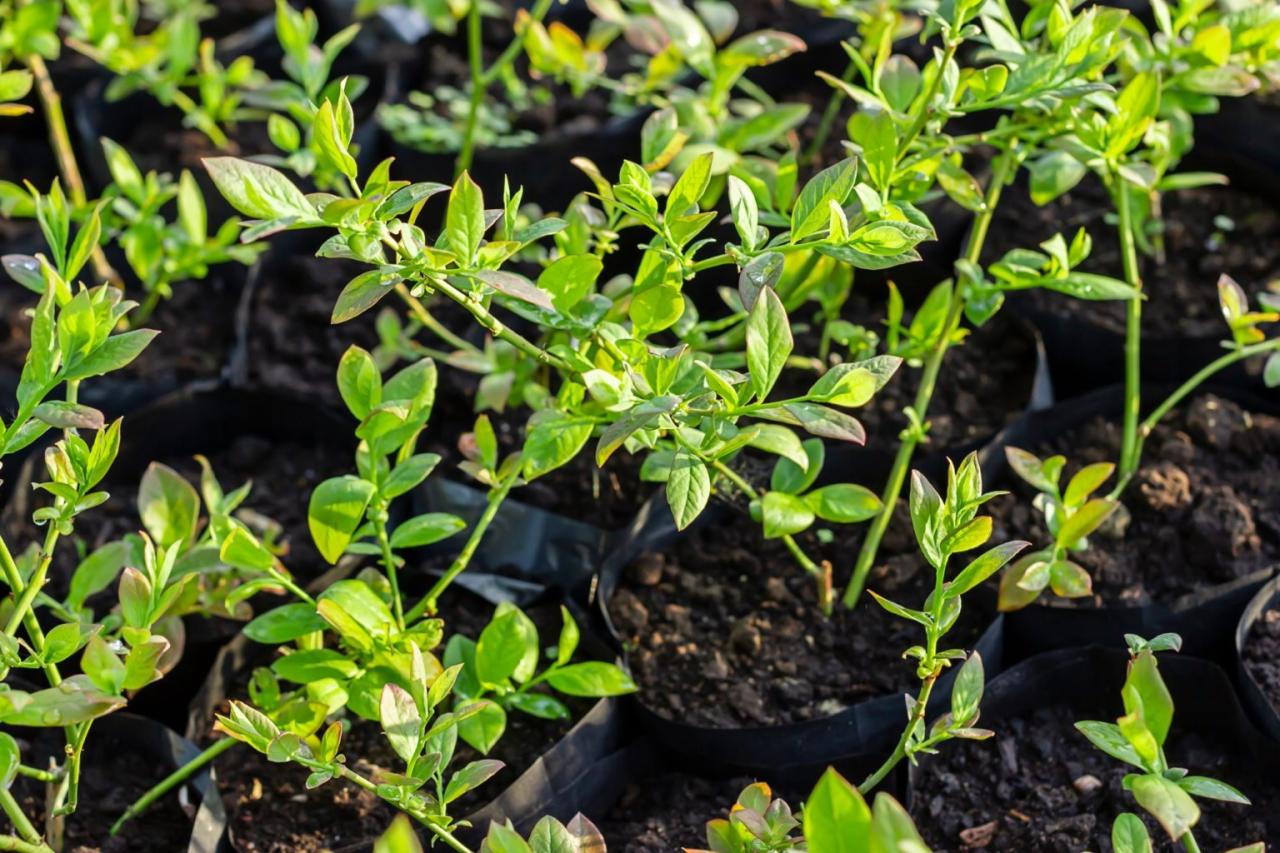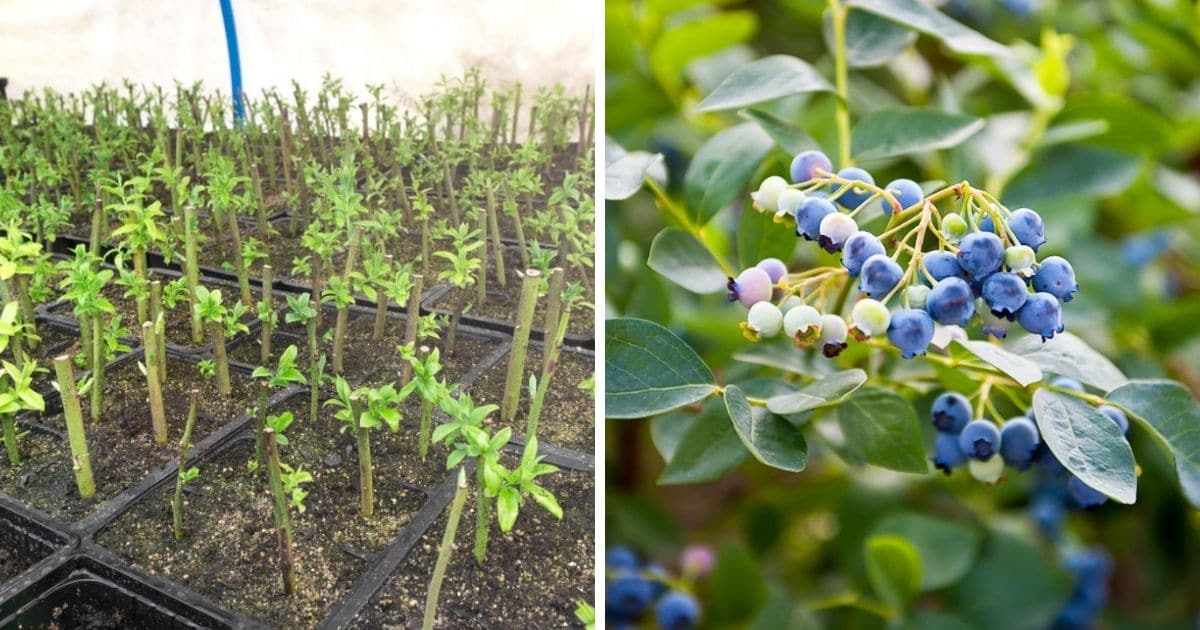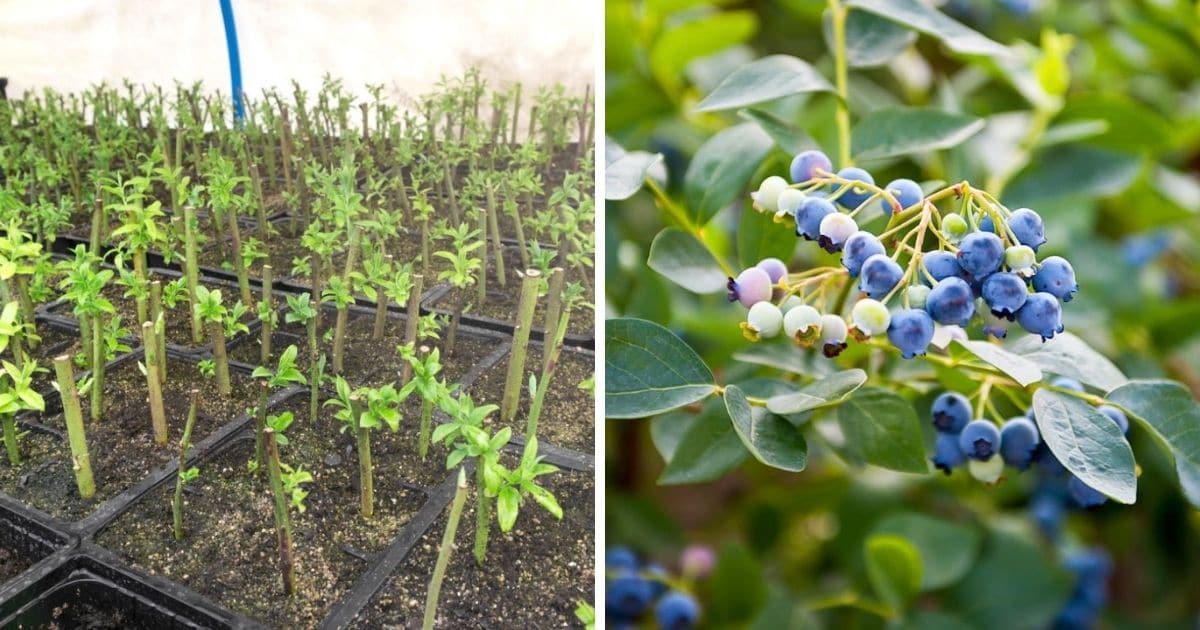The Ultimate Strategy for Propagating Blueberry Bushes in Your Garden is a comprehensive guide for home gardeners seeking to expand their blueberry patch. Whether you’re a seasoned grower or a novice enthusiast, this article provides step-by-step instructions and expert tips for successful blueberry propagation.
From understanding the different methods to nurturing young plants, we’ll cover all aspects of this rewarding endeavor, ensuring your garden flourishes with delicious blueberries.
Blueberry propagation offers numerous advantages, allowing you to create new bushes from existing plants, saving money on nursery purchases and expanding your blueberry harvest. This article explores various propagation methods, including cuttings, layering, and seeds, outlining the benefits and drawbacks of each technique to help you choose the best approach for your garden.
Understanding Blueberry Bush Propagation
Blueberry bushes are a popular addition to gardens, offering delicious fruit and vibrant foliage. Propagating your own blueberry bushes allows you to expand your garden, share with friends, or even start a small business. Understanding the different methods of propagation is essential for success.
Methods of Propagation
There are three main methods of propagating blueberry bushes: cuttings, layering, and seeds. Each method has its own advantages and disadvantages.
Cuttings
Cuttings involve taking a piece of stem from a healthy blueberry bush and encouraging it to develop roots. This is a common method used by commercial growers and home gardeners alike.
- Advantages:Cuttings are relatively easy to take and produce genetically identical plants to the parent bush. This ensures the new plants will have the same fruit quality and growth habits as the original.
- Disadvantages:Cuttings can take time to root, and success rates may vary depending on the type of blueberry bush and the time of year.
Layering
Layering involves bending a branch of the blueberry bush to the ground and encouraging it to develop roots while still attached to the parent plant. This method is less common than cuttings, but it can be a reliable way to propagate certain varieties.
- Advantages:Layering produces new plants with a higher success rate than cuttings and generally takes less time to establish.
- Disadvantages:Layering is not suitable for all varieties of blueberry bushes, and it can be more time-consuming than cuttings.
Seeds
Propagating blueberry bushes from seeds is a longer process that results in plants with a wide range of genetic variations. This means the new plants may not have the same characteristics as the parent plant.
- Advantages:Seeds are readily available and can be a cost-effective way to propagate large numbers of blueberry bushes.
- Disadvantages:Seed propagation is a time-consuming process, and the resulting plants may not be true to type. It may take several years for plants grown from seed to produce fruit.
Best Time of Year for Propagation
The best time of year to propagate blueberry bushes depends on the method chosen.
Cuttings
The best time to take cuttings is in the late summer or early fall, after the plant has finished fruiting. This allows the cuttings to develop roots before winter.
Layering
Layering can be done in the spring or early summer, when the plant is actively growing. This allows the branch to develop roots quickly.
Seeds
Blueberry seeds can be sown in the fall or spring. Seeds sown in the fall will experience a period of cold stratification, which is necessary for germination.
Preparing for Propagation

Before embarking on the propagation journey, it’s essential to create the right environment for your blueberry bushes to thrive. This includes understanding their soil preferences and selecting healthy parent plants for propagation.
Soil Conditions
Blueberry bushes prefer acidic soil with a pH range of 4.5 to 5.5. Soil with a pH above 6.0 can hinder nutrient absorption, leading to stunted growth and poor fruit production. To ensure proper drainage, choose a location with well-drained soil.
Waterlogging can lead to root rot and damage the plants. If your soil is heavy clay, consider amending it with organic matter like compost or peat moss to improve drainage and acidity.
Selecting Parent Plants
Choosing healthy parent plants is crucial for successful propagation. Select vigorous, disease-free bushes that have produced abundant fruit in previous seasons. Avoid plants showing signs of stress, such as wilting, yellowing leaves, or insect infestation.
Preparing for Propagation
The preparation process for propagation depends on the chosen method.
Cuttings
- Collect cuttings:In late summer or early fall, take 4-6 inch cuttings from the current season’s growth. Select healthy, disease-free stems with at least three nodes (the points where leaves grow).
- Prepare the cuttings:Cut the bottom of the cutting at an angle just below a node. Remove the leaves from the bottom two nodes.
- Dip the cuttings in rooting hormone:This helps promote root development.
- Plant the cuttings:Insert the cuttings into a well-draining potting mix, ensuring that the bottom two nodes are buried.
- Water thoroughly:Keep the potting mix moist but not soggy.
Layering
- Select a healthy branch:Choose a branch that is low to the ground and flexible enough to bend.
- Make a shallow cut:Use a sharp knife to make a shallow cut on the underside of the branch, just below a node.
- Pin the branch:Bend the branch down and pin it to the ground using a wire or rock.
- Cover the cut with soil:Cover the cut area with a few inches of soil.
- Water regularly:Keep the soil moist throughout the rooting process.
Seeds
- Collect seeds:Gather ripe blueberries from the parent plant. Remove the seeds from the fruit and rinse them thoroughly.
- Stratify the seeds:Blueberry seeds require a period of cold stratification to germinate. Place the seeds in a plastic bag filled with moist peat moss or vermiculite and store them in the refrigerator for 6-8 weeks.
- Sow the seeds:After stratification, sow the seeds in a well-draining potting mix. Cover the seeds lightly with soil and keep the mix moist.
- Provide adequate light:Blueberry seedlings require bright, indirect light.
Propagation Techniques: The Ultimate Strategy For Propagating Blueberry Bushes In Your Garden
Blueberry bushes can be propagated using various methods, each with its own advantages and considerations. These techniques allow you to create new plants from existing ones, expanding your blueberry patch or sharing the joy of these delicious berries with others.
Taking Cuttings, The Ultimate Strategy for Propagating Blueberry Bushes in Your Garden
Taking cuttings involves harvesting a section of a blueberry bush’s stem and encouraging it to develop roots. This method is a popular choice for blueberry propagation as it allows for the creation of multiple new plants from a single parent bush.
- Choosing the Right Cuttings:Select healthy, non-flowering stems from the current year’s growth. These stems are typically more pliable and have a higher success rate for rooting. Avoid using stems that are diseased or damaged.
- Cutting Preparation:Cut the stem into sections approximately 4-6 inches long. Ensure each cutting has at least three leaf nodes (the points where leaves grow). The bottom cut should be made at a 45-degree angle just below a node, while the top cut should be made horizontally above a node.
- Rooting Medium:Prepare a rooting medium by mixing equal parts peat moss and perlite. This combination provides good drainage and aeration, crucial for root development.
- Planting the Cuttings:Dip the cut ends of the cuttings in a rooting hormone solution, which stimulates root growth. Plant the cuttings in the rooting medium, ensuring that at least two nodes are buried. Keep the rooting medium moist, but not soggy.
- Providing Ideal Conditions:Place the cuttings in a humid environment, such as a propagator or a plastic bag. Maintaining a temperature of around 70°F (21°C) will encourage root development. Regular misting helps maintain humidity levels.
Layering
Layering is a technique that involves encouraging a stem to root while still attached to the parent plant. This method is particularly suitable for blueberry bushes as it allows for a higher success rate compared to cuttings.
The Ultimate Strategy for Propagating Blueberry Bushes in Your Garden involves understanding the unique characteristics of their seeds. While blueberry seeds are small, they are not always easy to germinate. For successful propagation, consider the challenges presented by spiky seeds, as outlined in Spiky Seeds: Why Every Gardener Should Know About Them , and adapt your techniques accordingly.
By mastering these strategies, you can cultivate healthy blueberry bushes in your garden, ensuring a bountiful harvest for years to come.
- Tip Layering:This technique involves bending a stem tip towards the ground and burying it in the soil. Secure the stem in place with a wire or rock. Once the stem develops roots, it can be severed from the parent plant and transplanted.
- Air Layering:Air layering involves removing a section of bark from a stem and covering the exposed area with a rooting medium. This method is often used for larger blueberry bushes where bending the stem to the ground is difficult.
Sowing Seeds
Propagating blueberry bushes from seeds is a more time-consuming process, but it can be a rewarding experience. Seeds require specific conditions for germination and growth, making this method less commonly used by home gardeners.
- Collecting Seeds:Collect ripe blueberries and extract the seeds. Rinse the seeds thoroughly to remove any pulp.
- Seed Stratification:Blueberry seeds require a period of cold stratification, mimicking the natural winter conditions, before they can germinate. Place the seeds in a moist paper towel or vermiculite and store them in a refrigerator for 8-12 weeks.
- Planting the Seeds:After stratification, sow the seeds in a seed starting mix. Use a shallow pot or tray and gently press the seeds into the soil. Maintain a temperature of around 70°F (21°C) and provide consistent moisture.
Caring for Propagated Bushes

Newly propagated blueberry bushes require special care to ensure their survival and healthy growth. This section covers essential practices for nurturing your young blueberry plants, helping them thrive and eventually produce delicious berries.
Watering Schedule
Proper watering is crucial for newly propagated blueberry bushes, especially during the establishment phase. A consistent watering schedule promotes root development and overall plant health.
The Ultimate Strategy for Propagating Blueberry Bushes in Your Garden starts with understanding the plant’s needs. While providing the right soil and sunlight is crucial, don’t underestimate the power of a healthy, vibrant you! A strong immune system can help you tackle any gardening challenge, and that’s where How Biota Herb Can Help You Feel Your Best Every Day comes in.
With a revitalized body and mind, you’ll be ready to tackle any gardening project, including the propagation of your blueberry bushes, with energy and enthusiasm!
- Frequency:Water newly propagated blueberry bushes deeply and thoroughly, aiming for the soil to be consistently moist but not waterlogged. The frequency of watering will vary depending on factors such as climate, soil type, and pot size. During hot and dry periods, you may need to water daily, while in cooler, wetter conditions, watering every few days may suffice.
- Depth:Water deeply enough to reach the roots, encouraging them to grow downwards. Shallow watering can lead to shallow root systems, making the plants more susceptible to drought stress.
- Monitoring:Check the soil moisture regularly, especially during the first few weeks after propagation. You can use your finger to test the soil moisture, or you can use a moisture meter.
Fertilization Routine
Blueberry bushes benefit from regular fertilization, especially during their establishment phase. Fertilizers provide essential nutrients that support healthy growth and fruit production.
- Type:Use a fertilizer specifically formulated for acid-loving plants, such as blueberries. These fertilizers contain the necessary nutrients in the correct ratios, including nitrogen, phosphorus, and potassium.
- Frequency:Fertilize newly propagated blueberry bushes every 4-6 weeks during the growing season, from spring to early fall. Reduce the frequency of fertilization during the winter months.
- Amount:Follow the instructions on the fertilizer label for the appropriate amount to apply. Over-fertilizing can damage the plants.
Pest Control
Blueberry bushes can be susceptible to various pests, including aphids, spider mites, and Japanese beetles. Regularly inspect your plants for signs of infestation and take appropriate action to prevent or control pests.
- Prevention:Encourage beneficial insects by planting flowers that attract them. These insects can help control pest populations.
- Inspection:Regularly inspect your blueberry bushes for signs of pest infestation, such as discolored leaves, webbing, or holes in the foliage.
- Treatment:If you notice pests, use organic pest control methods, such as insecticidal soap or neem oil, to control them. Avoid using harsh chemical pesticides, as they can harm beneficial insects and pollinator populations.
Hardening Off
Hardening off is a crucial step in preparing newly propagated blueberry bushes for outdoor conditions. This process gradually acclimates the plants to the elements, reducing transplant shock and improving their chances of survival.
- Duration:Start the hardening off process about 2 weeks before you plan to transplant the bushes outdoors.
- Exposure:Gradually increase the amount of time the bushes are exposed to direct sunlight and outdoor temperatures. Begin by placing them in a shaded location for a few hours each day. Over the next few days, gradually increase the amount of direct sunlight and the length of time they are exposed to the elements.
- Monitoring:Monitor the plants closely during the hardening off process, ensuring they are not wilting or showing signs of stress. If necessary, reduce the exposure time or provide additional shade.
Selecting the Ideal Location
Choosing the right location for your newly propagated blueberry bushes is essential for their long-term health and productivity. Consider the following factors:
- Sunlight:Blueberry bushes thrive in full sun to partial shade, receiving at least 6 hours of direct sunlight daily.
- Soil:Blueberry bushes prefer acidic soil with a pH between 4.5 and 5.5. You can amend the soil with peat moss, sulfur, or pine needles to lower the pH.
- Drainage:Blueberry bushes require well-drained soil to prevent root rot. If your soil is poorly drained, consider planting them in raised beds or containers.
- Spacing:Space blueberry bushes 3-4 feet apart to allow for adequate air circulation and growth.
Troubleshooting and Success
While propagating blueberry bushes is generally a rewarding process, there are some common challenges that can arise. Recognizing these issues and implementing appropriate solutions can significantly increase your success rate.
Identifying Common Problems
- Root Rot:Overwatering or poorly draining soil can lead to root rot, which is a fatal condition for blueberry bushes. The roots turn brown and mushy, and the plant wilts even when watered.
- Disease:Blueberry bushes are susceptible to various fungal diseases, such as powdery mildew and leaf spot. These diseases can weaken the plant and hinder its growth.
- Pest Infestations:Pests like aphids, scale insects, and spider mites can damage blueberry bushes by sucking sap from the leaves and stems.
- Lack of Root Development:If the cuttings do not develop strong root systems, they may struggle to survive. This can be due to improper propagation techniques or unfavorable environmental conditions.
- Slow Growth:Blueberry bushes may experience slow growth if they are not receiving adequate nutrients, sunlight, or water.
Solutions for Common Problems
- Root Rot:Use well-draining soil and avoid overwatering. Consider adding a layer of mulch to help retain moisture and prevent soil compaction.
- Disease:Apply fungicides as needed to prevent and treat fungal diseases. Choose disease-resistant blueberry varieties when possible.
- Pest Infestations:Monitor your blueberry bushes regularly for signs of pests. Use insecticidal soap or neem oil to control infestations.
- Lack of Root Development:Ensure the propagation environment provides sufficient humidity and warmth. Use a rooting hormone to encourage root growth.
- Slow Growth:Provide adequate sunlight, water, and nutrients. Fertilize your blueberry bushes with a balanced fertilizer specifically designed for acid-loving plants.
Signs of Successful Propagation
- Root Development:Gently tug on the cutting to check for resistance. If the cutting feels firmly rooted, it’s a good sign of success.
- New Growth:The emergence of new leaves and shoots indicates that the cutting has successfully rooted and is growing.
- Healthy Color:The leaves of a successfully propagated blueberry bush should be a vibrant green color, free from discoloration or wilting.
Maximizing Propagation Success
- Choose Healthy Cuttings:Select cuttings from vigorous and disease-free blueberry bushes.
- Use Sharp Tools:Clean, sharp pruning shears or a knife will make clean cuts, reducing the risk of infection.
- Use Rooting Hormone:Applying rooting hormone to the base of the cuttings can significantly enhance root development.
- Provide Optimal Growing Conditions:Ensure the propagation environment provides adequate humidity, warmth, and light.
- Monitor Regularly:Check your cuttings frequently for signs of root development, disease, or pests.
Final Conclusion
By mastering the techniques Artikeld in this guide, you’ll be equipped to propagate your own blueberry bushes, ensuring a plentiful supply of fresh, homegrown berries for years to come. Remember to pay close attention to the specific needs of your chosen propagation method, providing the appropriate care and attention to ensure the success of your new blueberry plants.
With dedication and a little patience, you’ll soon be enjoying the sweet fruits of your labor, reaping the rewards of a bountiful blueberry harvest from your own garden.
Query Resolution
How long does it take for a blueberry bush to start producing fruit after propagation?
It typically takes 2-3 years for a propagated blueberry bush to start producing fruit. However, this can vary depending on the propagation method, the variety of blueberry, and the growing conditions.
Can I propagate blueberry bushes from store-bought plants?
Yes, you can propagate blueberry bushes from store-bought plants, but it’s essential to ensure they are healthy and disease-free. Look for plants with vigorous growth and no signs of pests or diseases.
What are the best blueberry varieties for propagation?
The best blueberry varieties for propagation are those that are well-suited to your climate and soil conditions. Some popular varieties include ‘Northland,’ ‘Bluecrop,’ and ‘Pink Popcorn.’
Can I propagate blueberry bushes from seeds?
While it’s possible to propagate blueberry bushes from seeds, it’s a more challenging process than using cuttings or layering. Seed-grown blueberry bushes may not inherit the same characteristics as the parent plant and can take longer to produce fruit.
